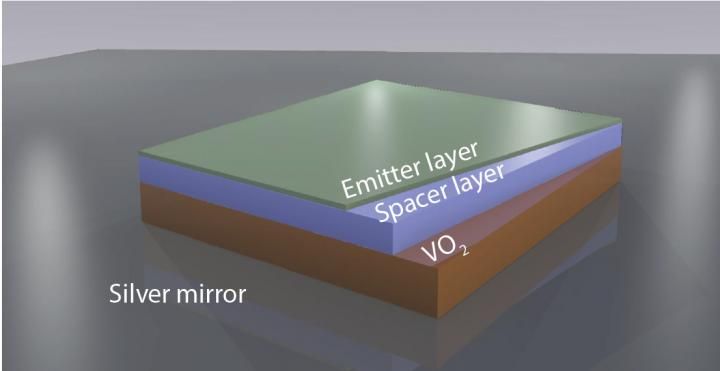Researchers transform slow emitters into fast light sources
Advertisement
Researchers from Brown University, in collaboration with colleagues from Harvard, have developed a new way to control light from phosphorescent emitters at very high speeds. The technique provides a new approach to modulation that could be useful in all kinds of silicon-based nanoscale devices, including computer chips and other optoelectronic components.

Phosphors are efficient light emitters but they're not optimal for high-speed communications because they turn on and off slowly. Researchers from Brown and Harvard have now found a way to modulate light from phosphor emitters three orders of magnitude faster using phase-change materials (VO2, in this case), which could make phosphors useful in a range of new optoelectronic applications.
Zia Lab / Brown University
"Our results demonstrate relatively fast modulation from fundamentally slow phosphorescent light emitters," said Rashid Zia, associate professor of engineering and physics at Brown and senior author of a new paper describing the work. "We think this could help make phosphors useful in a variety of new systems and settings."
In this latest work, Zia and collaborators, including researchers from Shriram Ramanathan's group at Harvard University, took a different approach to modulation.
"Instead of changing how much light is coming out, which can only be done slowly in phosphor emitters, we came up with a system that changes another quality of that light, namely the color or spectrum of light emission, by rapidly changing the environment around the emitter," Zia said.
The work was led by Sebastien Cueff, a postdoctoral researcher in Zia's lab. Cueff started with an emitter made of erbium ions, an important phosphor that is widely used in fiber-optic telecommunication networks. He combined that with vanadium dioxide (VO2). VO2 is a phase-change material that, when pumped with energy, changes very quickly from a transparent insulating state to a reflective metallic state. This change in reflectivity, in turn, switches how nearby erbium ions emit light. As the VO2 changes phase, the erbium emissions go from being generated mostly by magnetic dipole transitions, to being generated mostly by electric dipole transitions. Those two emission pathways have distinct spectra, and the modulation back and forth between the two can be used as a means to encode information.
The researchers showed that this direct modulation of light emission could be done as quickly as the VO2 phase could be changed, which is much faster than the speed at which erbium can be turned on and off. The test system used in these initial experiments showed that the system could be switched three orders of magnitude faster than the optical lifetime of erbium.
"Phosphorescent emitters have been considered impractical for high speed applications because of their intrinsically long lifetimes," Zia said. "Our results provide a simple way to circumvent this limitation and modulate their emission at high speeds."
And that could enable the use of phosphors in new applications. One example could be optical communications networks on computer chips.
Prototype on-chip networks have used semiconductor lasers as light emitters. They can modulate very quickly, but they have downsides. Semiconductors can't be grown directly on a silicon chip, so fabrication can be difficult. Using indirect means of modulation makes for bulky systems that take up a lot of real estate on a chip. What's more, semiconductor lasers are not particularly efficient. They produce a lot of heat along with light, which is a problem on a silicon chip.
Erbium and other phosphors, on the other hand, can be deposited directly on silicon, making fabrication easier. And phosphors are highly efficient, so heat is less of a concern. There's still more work to be done to get such a system up to a speed that would be useful on a chip, but Zia and his colleagues think it's possible.
In this initial experiment, the researchers used a laser to zap the VO2 and cause it to change phase. A faster means of changing the VO2 phase could make the system much faster still.
Zia and his group plan to continue to refine the technique, but they describe this first set of experiments as an important proof of concept. "We ... hope that the device and concept presented here will engage both academic and industrial researchers working on optoelectronics and nanophotonics," the researchers write.




























































